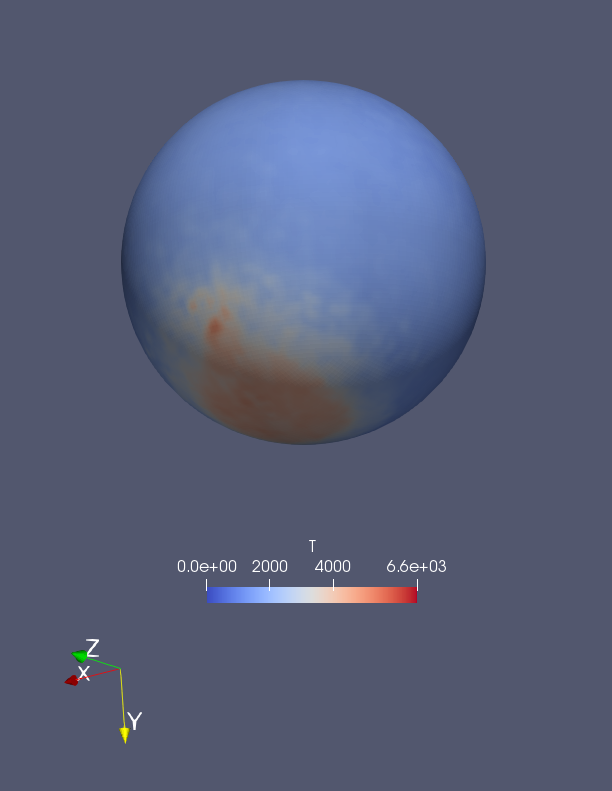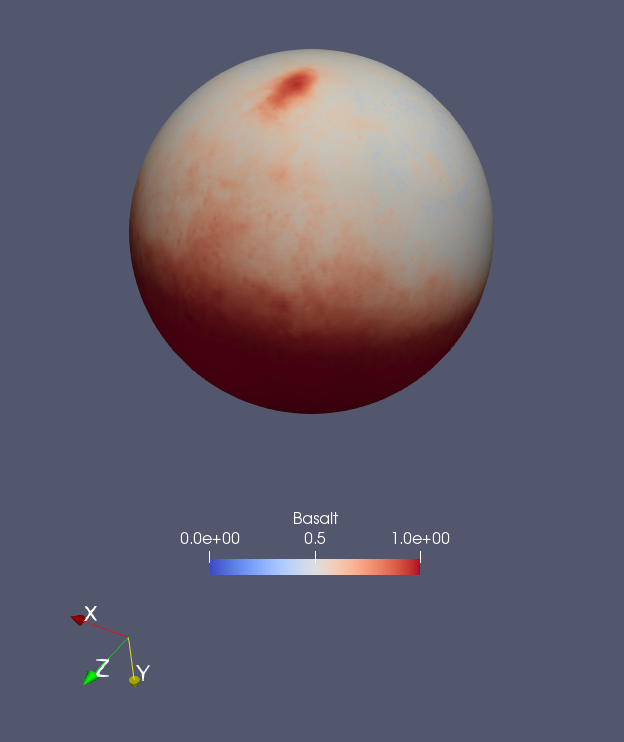- 1ETH Zürich, Institute of Geophysics, Department of Earth Science, Zürich, Switzerland (karwai.cheng@erdw.ethz.ch)
- 2Physics Institute, University of Bern, Bern, Switzerland
- 3Bayerisches Geoinstitut, University of Bayreuth, Bayreuth, Germany
The Martian dichotomy features a 5.5 km contrasts in topography and a potential ~ 25 km difference in crustal thickness [1], depending on the crustal density assumption [2], between the older southern highlands and the younger northern lowlands. It is thought to be the most ancient feature observed on Mars and have formed within the first 400-500 Myr of Martian history [3].
While the formation mechanism of the dichotomy is still under debate, our previous models [4] have successfully demonstrated that a southern giant impact does not only form a thicker crust on the impacted site, but also have a significant consequence in the location of magmatism in the next billions of years. In addition to the shock wave-generated impact melt, the temperature within the mantle after a giant impact is shown to be well above the silicate solidus. Therefore, deep mantle melting is expected to generate a local magma ocean. Shortly following the crystallization of the local magma ocean, depleted residues spread within the upper mantle from the southern impacted site northwards. This layering, deficient in heat producing elements, assists the faster formation of a thicker and more stable lithosphere in the North. This in turns maintains a lower crust production rate in the north. Rather, due to the north-south different in thermal and composition gradient, melt production and therefore magmatism are focused at low latitude regions of the planet and last until geologically recent times, which is consistent with observations.
While our previous study can demonstrate the important interactions among impact-induced local magma ocean, crust formation and mantle flow, the impact scenario we used is rather simplified, as the associated thermal anomaly is parametrised and extrapolated from smaller head-on impact experiments. In order to account for a more realistic impact scenario, we use smoothed particle hydrodynamics (SPH) simulations [5] to model the first 24 hours of a giant impact between proto-Mars and its impactor. The SPH result is then transferred to the mantle convection code StagYY [6], as an initial thermal condition, to simulate the long-term evolution of the crust and mantle for the subsequent 4.5 billion years. We systematically vary the impactor size, angle, velocity and pre-impact Martian mantle temperature.
Our result shows that a 45-degree impact does not form a Martian dichotomy-like crustal structure, and a 15-degree impact is a better match. While a 500 km-radius impactor may not generate crust extensive enough, a 750 km-radius impactor can form a thickened crust that covers the whole southern hemisphere. Resultant mantle flow from a larger impactor size is a key to suppressing multiple mantle plumes as well.

Fig 1. Temperature field (result from SPH model) at the start of simulation t=0 Myr

Fig 2. Compositional field at t=~500 Myr
[1] Watters, T., McGovern, P., & Irwin III, R. (2007). Hemispheres Apart: The Crustal Dichotomy on Mars. Annual Review Of Earth And Planetary Sciences, 35(1), 621-652.
[2] Wieczorek, M., Broquet, A., McLennan, S., Rivoldini, A., Golombek, M., & Antonangeli, D. et al. (2022). InSight constraints on the global character of the Martian crust. Journal Of Geophysical Research: Planets. doi: 10.1029/2022je007298
[3] Taylor, S., & McLennan, S. (2009). Planetary crusts. Cambridge, UK: Cambridge University Press.
[4] Cheng, K.W., Tackley, P.J., Rozel, A.B., Golabek, G.J. (2021). Martian Dichotomy: Impact-induced Crustal Production in Mantle Convection Models, Abstract [DI35B-0023] presented at 2021 Fall Meeting, AGU, New Orleans, LA, 13-17 Dec.
[5] Emsenhuber, A., Jutzi, M., Benz, W. (2018). SPH calculations of Mars-scale collisions: The role of the equation of state, material rheologies, and numerical effects. Icarus, 301, 247-257
[6] Tackley, P. (2008). Modelling compressible mantle convection with large viscosity contrasts in a three-dimensional spherical shell using the yin-yang grid. Physics Of The Earth And Planetary Interiors, 171(1-4), 7-18.
How to cite: Cheng, K. W., Rozel, A., Ballantyne, H., Jutzi, M., Golabek, G., and Tackley, P.: Martian crustal dichotomy formation and its effect on volcanisms: mantle convection models, Europlanet Science Congress 2022, Granada, Spain, 18–23 Sep 2022, EPSC2022-1045, https://doi.org/10.5194/epsc2022-1045, 2022.

